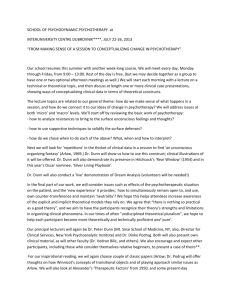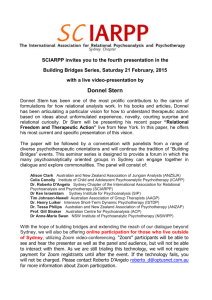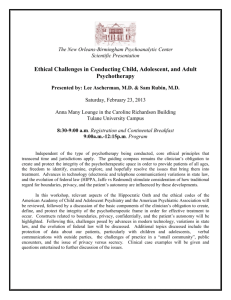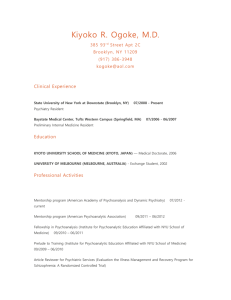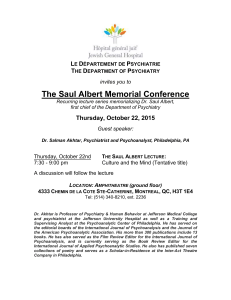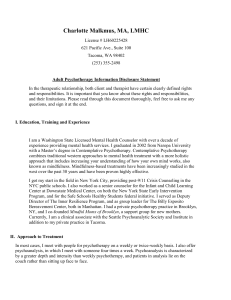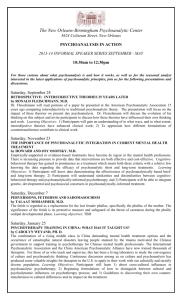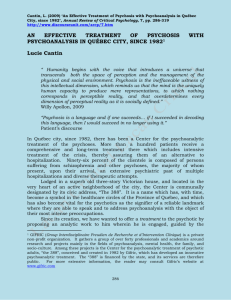Psychoanalytic Psychotherapy with the Person with Psychotic Process
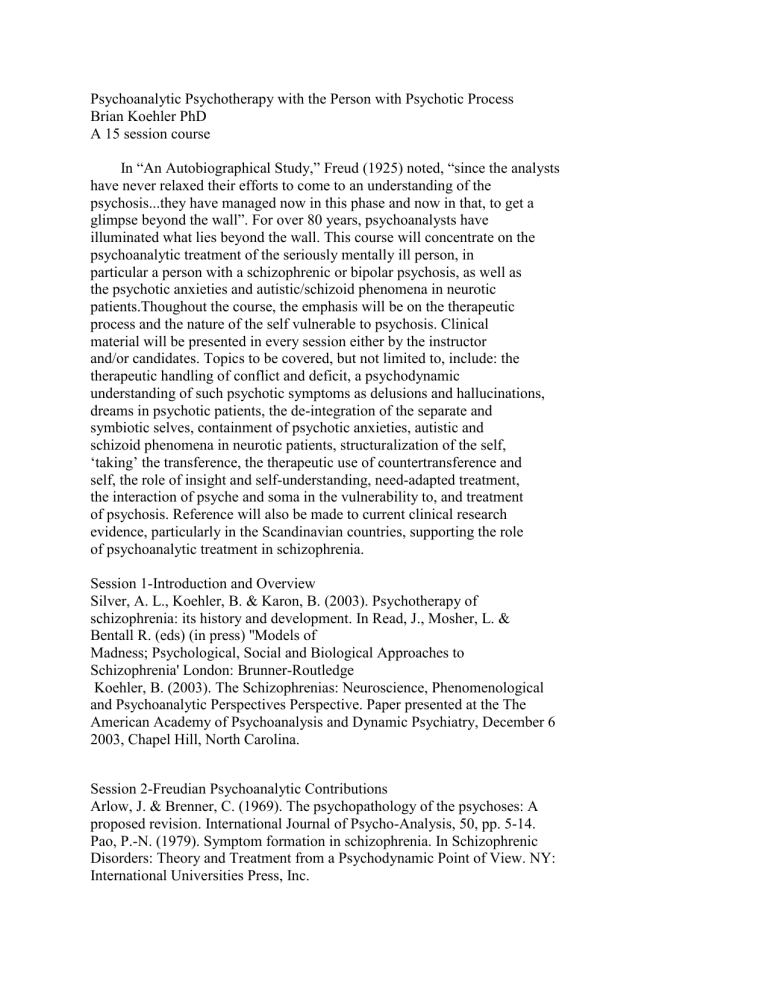
Psychoanalytic Psychotherapy with the Person with Psychotic Process
Brian Koehler PhD
A 15 session course
In “An Autobiographical Study,” Freud (1925) noted, “since the analysts have never relaxed their efforts to come to an understanding of the psychosis...they have managed now in this phase and now in that, to get a glimpse beyond the wall”. For over 80 years, psychoanalysts have illuminated what lies beyond the wall. This course will concentrate on the psychoanalytic treatment of the seriously mentally ill person, in particular a person with a schizophrenic or bipolar psychosis, as well as the psychotic anxieties and autistic/schizoid phenomena in neurotic patients.Thoughout the course, the emphasis will be on the therapeutic process and the nature of the self vulnerable to psychosis. Clinical material will be presented in every session either by the instructor and/or candidates. Topics to be covered, but not limited to, include: the therapeutic handling of conflict and deficit, a psychodynamic understanding of such psychotic symptoms as delusions and hallucinations, dreams in psychotic patients, the de-integration of the separate and symbiotic selves, containment of psychotic anxieties, autistic and schizoid phenomena in neurotic patients, structuralization of the self,
‘taking’ the transference, the therapeutic use of countertransference and self, the role of insight and self-understanding, need-adapted treatment, the interaction of psyche and soma in the vulnerability to, and treatment of psychosis. Reference will also be made to current clinical research evidence, particularly in the Scandinavian countries, supporting the role of psychoanalytic treatment in schizophrenia.
Session 1-Introduction and Overview
Silver, A. L., Koehler, B. & Karon, B. (2003). Psychotherapy of schizophrenia: its history and development. In Read, J., Mosher, L. &
Bentall R. (eds) (in press) ''Models of
Madness; Psychological, Social and Biological Approaches to
Schizophrenia' London: Brunner-Routledge
Koehler, B. (2003). The Schizophrenias: Neuroscience, Phenomenological and Psychoanalytic Perspectives Perspective. Paper presented at the The
American Academy of Psychoanalysis and Dynamic Psychiatry, December 6
2003, Chapel Hill, North Carolina.
Session 2-Freudian Psychoanalytic Contributions
Arlow, J. & Brenner, C. (1969). The psychopathology of the psychoses: A proposed revision. International Journal of Psycho-Analysis, 50, pp. 5-14.
Pao, P.-N. (1979). Symptom formation in schizophrenia. In Schizophrenic
Disorders: Theory and Treatment from a Psychodynamic Point of View. NY:
International Universities Press, Inc.
Session 3- Contemporary Freudian Perspectives
Eric Marcus (1992). Psychoanalytic psychotherapy and psychoanalysis of psychosis. In Psychosis and Near psychosis: Ego Function, Symbol
Structure, Treatment, pp. 217-249. NY: Springer-Verlag.
Thomas Freeman (2001). Treating and studying the schizophrenias. In P.
Williams (Ed.), A Language for Psychosis. NY: Brunner-Routledge.
Simo Salonen (2002). Understanding psychotic disorder. Scandinavian
Psychoanalytic Review, 25, pp. 143-146.
Session 4-Post-Kleinian Developments
Brian Koehler (1994). Kleinian Contributions to the Understanding and
Treatment of Psychotic Patients. Paper presented at the XIth International
Symposium for the Psychotherapy of Schizophrenia, Washington, D.C., June
13, 1994.
Franco de Masi (1997). Intimidation at the helm: superego and hallucinations in the analytic treatment of a psychosis. The International
Journal of Psychoanalysis, 78 (3), pp. 561-576.
Session 5-Post-Kleinian Developments
Henri Rey (1994). The schizoid mode of being and the space-time continuum
(before metaphor). In Universals of Psychoanalysis in the Treatment of
Psychotic and Borderline states: factors of
Space-Time and Language, pp. 8-30.London: Free Association Books.
Murray Jackson (2001). Paranoid schizophrenia-space-time factors:
“Conrad.” In Weathering the Storms: Psychotherapy for Psychosis, pp.
120-140. London: Karnac.
Franco De Masi (2003). On the nature of intuitive and delusional thought:
Its implications in clinical work with psychotic patients. International
Journal of Psychoanalysis, 84, pp. 1149-1169.
Session 6-Autistic Phenomena and Psychosis in Adolescence: The
Contributions of Frances Tustin, Sydney Klein and Julia Pestalozzi
Frances Tustin (1991). Revised understandings of psychogenic autism.
International Journal of Psycho-Analysis, 72, pp. 585-591.
Sydney Klein (1980). Autistic phenomena in neurotic patients.
International Journal of Psych-Analysis, 61, 3, pp. 395-402.
Julia Pestalozzi (2003). The symbolic and concrete: Psychotic adolescents in psychoanalytic psychotherapy. International Journal of Psychoanalysis,
84, pp. 733-753.
Session 7- Interpersonal Psychoanalysis
H. S. Sullivan (1956). Schizophrenia, paranoid states, and related conditions. In Clinical Studies in Psychiatry, pp. 304-360. NY: W. W.
Norton & Co., Inc.
Frieda Fromm-Reichmann (1959). Psychotherapy of schizophrenia. In D. M.
Bullard (Ed.), Psychoanalysis and Psychotherapy: Selected Papers of Frieda
Fromm-Reichmann, pp. 194-209. Chicago: The University of Chicago Press.
Frieda Fromm-Reichmann (1959). Basic problems in the psychotherapy of schizophrenia. In D. M. Bullard (Ed.), Psychoanalysis and Psychotherapy:
Selected Papers of Frieda Fromm-Reichmann, pp. 210-217. Chicago: The
University of Chicago Press.
Session 8-Interpersonal Psychoanalysis: The Contributions of Otto Allen
Will & Harold Searles
Otto Allen Will (1987). Human relatedness and the schizophrenic reaction.
In J. Sacksteder, D. Schwartz & Y. Akabane (Eds.), Attachment and the
Therapeutic Process: Essays in Honor of Otto Allen, Jr., M.D., pp
263-297.Madison, CT: International Universities Press, Inc.
Harold Searles (1979).Transitional phenomena and therapeutic symbiosis. In
Countertransference and Related subjects, pp. 196-227. NY: International
Universities Press, Inc.
Wagaman, R. M. & Searles, H. F. (1990 ). Infinite reflections: The opening phase of intensive psychotherapy with a chronically schizophrenic patient.
The Journal of the American Academy of Psychoanalysis, 18 (1), pp. 99-114.
Session 9-Contemporary Interpersonal Psychoanalysis and Silvano Arieti
Silvano Arieti (1978). The schizophrenic patient in office practice. In On
Schizophrenia, Phobias, Depression, Psychotherapy and the Farther Shores of Psychiatry: Selected Papers of Silvano Arieti MD, pp. NY:
Brunner/Mazel.
Ann-Louise Silver (1997). Chestnut Lodge, then and now. Contemporary
Psychoanalysis, 33, (2), pp 227-249.
Leston Havens (2000). Treating Psychoses. In A. N. Sabo & L. Havens (Eds.)
The Real World Guide to Psychotherapy Practice, 149-162. Cambridge, MA:
Harvard University Press.
Session 10-Psychoanalysis and Bipolar Disorder
Brian Koehler (2000). The Razor’s Edge: The Struggle to Preserve Self and
Object Relations in the Psychoanalytic Therapy of Patients with a Bipolar
Disorder. Paper presented at “Storm Warning: Recognizing and Treating Mild and Moderate forms of Manic depression in Analytic patients,” sponsored by
The Psychoanalytic Psychotherapy Study Center, November 18-19, 2000, New
York, NY.
Session 11- The Contributions of DW Winnicott and British Object Relations
D. W. Winnicott (1974). Fear of breakdown. International Review of
Psycho-Analysis, 1, pp. 103-107.
Edmund DeLaCour (1989). Fear of breakdown: a case with multiple psychotic episodes. In M. G. Fromm & B. L. Smith (Eds.), The Facilitating
Environment: Clinical Applications of Winnicott’s Theory, pp. 558-580.
Madison, CT: International Universities Press, Inc.
Harry Guntrip (1994). Deeper perception of the schizoid problem. In Jeremy
Hazell (Ed.). Personal Relations Therapy: The Collected Papers of H. J. S.
Guntrip, pp. 127-156.Northvale, NJ: Jason Aronson, Inc.
Session 12- Object Relations & Independent Psychoanalysis
David Feinsilver (1986). Pao’s telescopic overview of treatment. In
Towards a Comprehensive Model for Schizophrenic Disorders: Psychoanalytic
Essays in Memory of Ping-Nie Pao, MD, pp237-258. Hillsdale, NJ: The
Analytic Press.
Michael Conran (1999). Sorrow, vulnerability and madness. In Paul Williams
(Ed.) Psychosis
(Madness), pp. 27-43. London: The Institute of Psychoanalysis.
Paul Williams (2001). Psychotic developments in a sexually abused borderline patient. In Paul Williams (Ed.) A Language for Psychosis:
Psychoanalysis of Psychotic States, pp. 175-199. NY:Brunner-Routledge.
Session 13-Lacanian Psychoanalysis
Jean-Max Gaudilliere & Francoise Davoine (1993).Mental illness and social link: uses of “counteridentification” in the psychotherapy of schizophrenia. In G. Benedetti & P. M. Furlan (Eds.), The Psychotherapy of Schizophrenia: Effective Approaches-Controversies, Critiques and
Recommendations, pp. 153-159. Bern: Hogrefe & Huber Publishers.
Stefaan Soemen & Jozef Corveleyn (2003). The vicissitudes of corporeality in schizophrenia: A psychoanalytic approach. In J. Corveleyn & P. Moyaert
(Eds.) Psychosis: Phenomenological and psychoanalytic approaches, pp.
27-41. Belgium: Leuven University Press.
Paul Moyaert (2003). Body, drive, and affect in schizophrenia, from the psychoanalytic perspective. In J. Corveleyn & P. Moyaert (Eds.)
Psychosis: Phenomenological and psychoanalytic approaches, pp. 43-57. Belgium: Leuven University Press.
Session 14-Self-Psychology & Intersubjectivity
Heinz Kohut (1996). Paranoia and self psychology. In Paul Tolpin & Marian
Tolpin (Eds.) Heinz Kohut: The Chicago Institute lectures, pp. 141-158.
Hillsdale, NJ: The Analytic Press.
Heinz Kohut (1996). A new mode of thinking: narcissism and the psychology of psychosis. In Paul Tolpin & Marian Tolpin (Eds.) Heinz Kohut: The
Chicago Institute Lectures, pp. 275-289. Hillsdale, NJ: The Analytic Press.
George Atwood, Donna Orange & Robert Stolorow (2001). Shattered worlds/psychotic states: a post-Cartesian view of the experience of personal annihilation. Psychoanalytic Psychology, 19 (2), pp. 281-306.
Session 15- Psychoanalytic Contributions of Gaetano Benedetti and European
Psychoanalysis
Gaetano Benedetti (1990). Depression, psychosis, schizophrenia. In P.
Borri & R. Quartesan (Eds.), USA-Europe Joint Meeting on Therapies and
Psychotherapy of Schizophrenia, pp. 7-17.
Perugia, Italy: ARP.
Gaetano Benedetti (1992). The psychotherapy of psychotic and schizophrenic patients and factors facilitating this. In P. Borri b(Ed.), USA-Europe
Conference on Facilitating Climate for the Therapeutic relation in Mental
Health Services, pp. 7-20. Perugia, Italy: ARP.
Brian Koehler (2003). Interview with Gaetano Benedetti, M.D. The Journal of the American Academy of Psychoanalysis and Dynamic Psychiatry, 31 (1), pp. 75-87.

